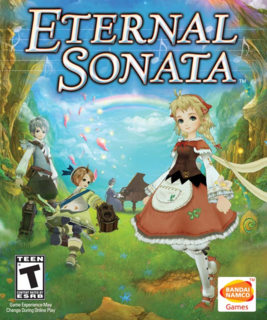Eternal Sonata combines music with colorful characters, but dull mechanics hold it back.
The two most compelling aspects of Eternal Sonata are its art style and its source material. The game draws its plot from one of the more commonly known facts about famed Polish pianist Frederic Chopin - that he had very lucid dreams on his deathbed. The game's plot uses a little creative license in this area; the entire world you explore takes place within one of Chopin's final dreams, more specifically the one h has right before he dies. As such, the game's theme weighs heavily in th area of personal identity and coming to grips with one's own death. One other main character, a young woman named Polka is also terminally ill, with the side effect of her disease being that she can use a form of magic known only to her. The art style is equally detailed. All of the characters are drawn in a gorgeous cell shaded style and are all unique and often pleasantly strange way. For instance, Polka has to long strands of hair that are always miraculously straight for about three feet and then curly near the end. Sure, it sounds strange (it is), but it works and it serves to give her character a little bit more personality. All of the other characters all have this weird traits to them, as well. Finally, Eternal Sonata battle system on a fundamental level is a bit more involved than the battle systems in most Japanese role-playing games. It's pseudo real-time - the characters are placed on a field of battle and are able to move around freely, but they're given a set amount of time (usually around five seconds or so). There's a dedicated attack button and when you character attacks, the time limit is increased by a second or so with each successful hit. Aside from these basics, the system gets interesting in the way that characters use the light and dark areas of the battlefield to their advantage. The game feature two unique sets of attacks for both these kinds of areas. Characters can only use Light attacks in areas that are brightly lit and can only use Dark attacks in areas that are draped in shadow. The music in Eternal Sonata is probably its most charming aspect. Many of the score pieces in the game are either Chopin's original work or pieces derived from Chopin's original work. Even if you've never heard of Chopin or heard any of his compositions, you'll find yourself drawn into them because they're simply amazing. It's also fantastic that the pieces that the game's composer derived from Chopin's original work never betray their source material.
The Bad
The problem with this battle system is not really in the battle system itself, but in the fact that you pretty much fight the same battle over and over and over again. In Eternal Sonata, you can see your enemies on the field map before actually doing battle with them - when you touch an enemy on the field, you go into battle with it, but in each new area you come to, there only three or so different battle combinations and only two of those combinations are played more commonly. This lack of variety in the battle combinations quickly gets boring, even with the fast paced battle style. As for the story; as mentioned it draws heavily on deep source material, but the story itself is told in a rather dull way. The story in Eternal Sonata is essentially your basic "people overthrow the evil government" story, but this time thee government is using a poison to turn the people into its personal army to invade another country. Even this small twist has been seen before in other games, so it doesn't really bring the story out of boredom. The English voice acting is terrible to say the least - each of the voice actors seems to have taken th approach of voicing the characters as though they're in a small child's television program, so many of the lines will sound as through they're geared towards a five year-old. The Japanese voice acting isn't really any better and this could perhaps be the first game where you might favor the localized acting over the original Japanese. Exploring the field maps feels pretty basic, in addition to your character feeling a little "floaty". By this, I mean your character doesn't really feel like he's walking around in the world, as much as he feels like he's just floating over it make a walking motion. The controls are also a little loose, so you'll find yourself running in the invisible walls quite a bit trying to find your way around.

